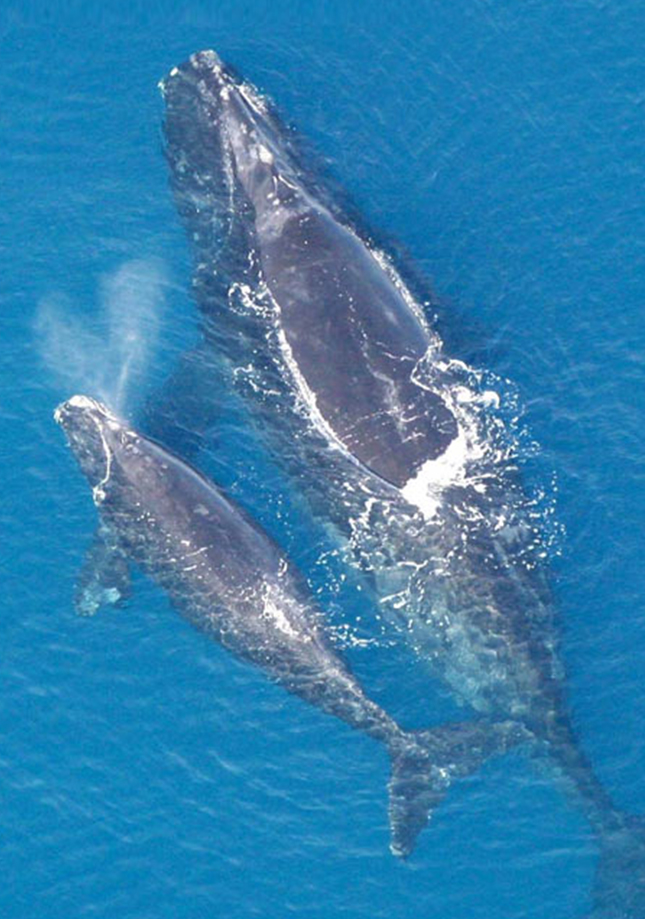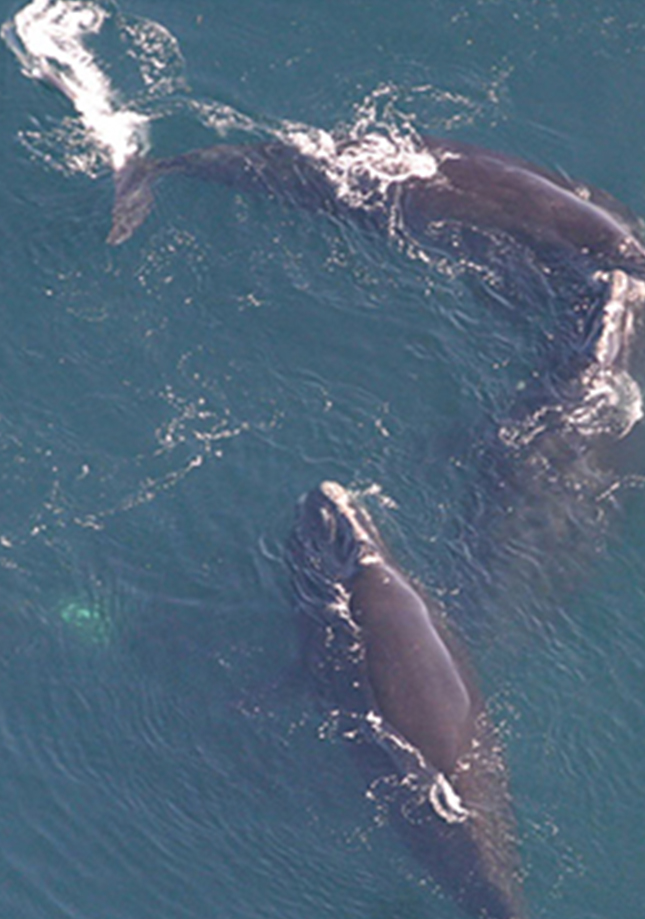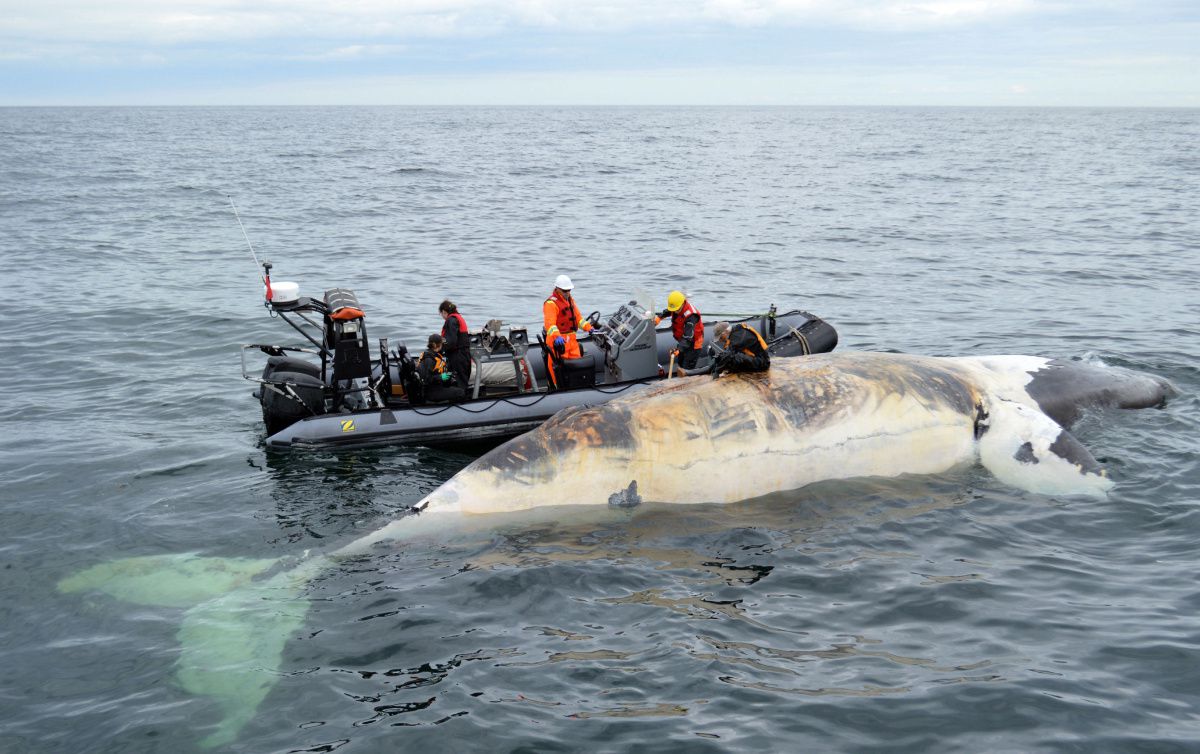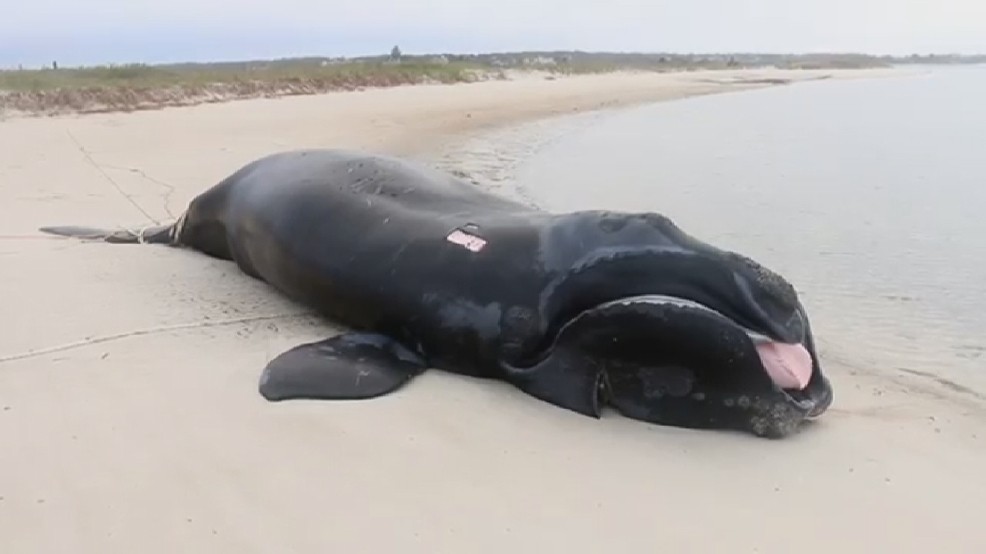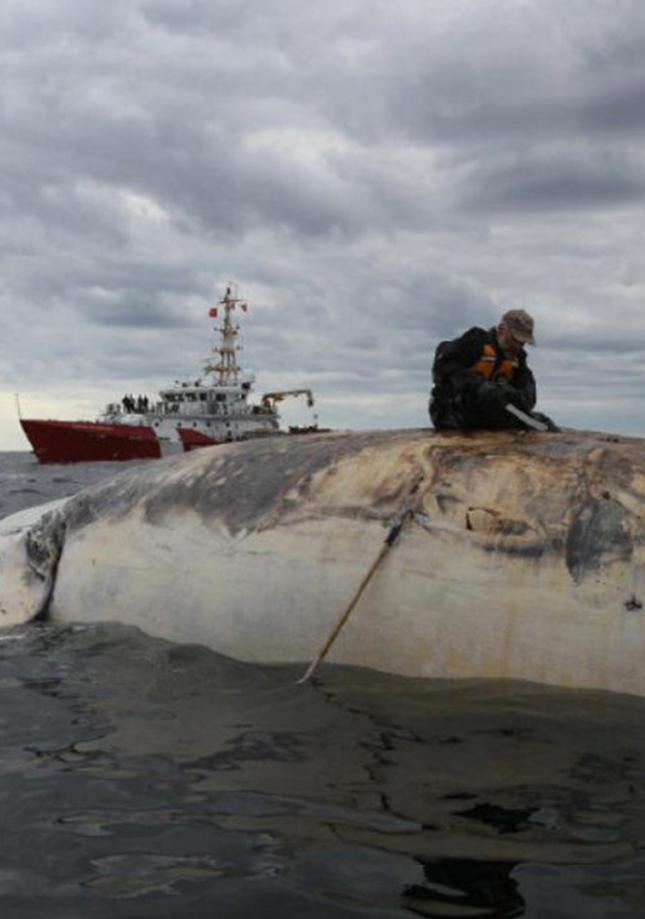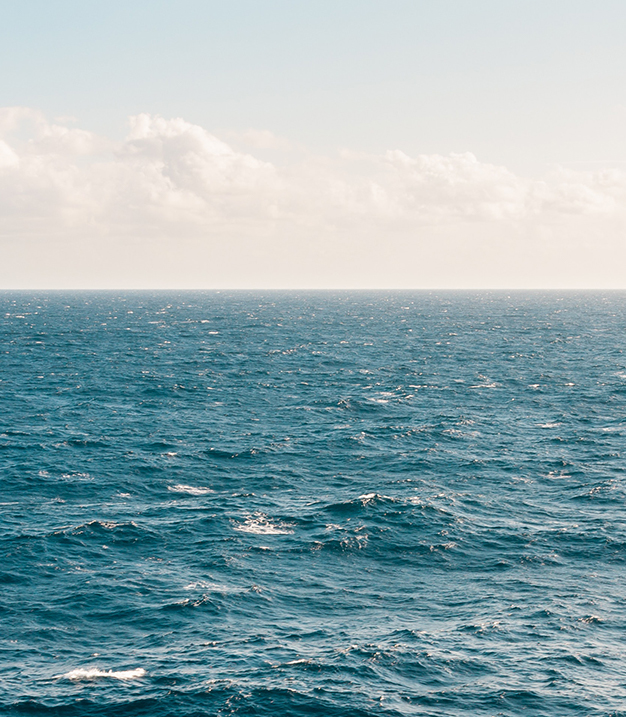Background
The North Atlantic Right Whale is the most endangered large whale on the planet. Historically found throughout the Atlantic Ocean, it was named the “right” whale because its large body and thick blubber made it attractive to hunt – it can weigh up to 70,000 kilograms and measure up to 18 metres. This led to centuries of overexploitation.
Globally protected from commercial whaling in 1935, the North Atlantic Right Whale is now almost solely found in the Western Atlantic Ocean, from the coast of Florida up to Atlantic Canada. Increasing numbers of North Atlantic Right Whale are being killed by human activities, making this a major factor limiting the population’s recovery by impacting overall population survival. Specifically, North Atlantic Right Whales are highly susceptible to ship strikes and entanglement in fishing gear due to their habitat being heavily used by the shipping and fishing industries. This, combined with lower calving rates since 2010, is restricting the species’ ability to recover, placing them at risk for extinction in as little as 20 years.
With increasing risks to North Atlantic Right Whales from entanglement and ship strikes, we are working alongside government and industry to better quantify the risks, and to develop innovative approaches to decrease the threat of entanglement and improve fisheries management measures.
Videos
In the News
-
Celebrating 10 Years of iNaturalist Canada: A Decade of Tracking Species at Risk
December 11, 2025 - iNaturalist Canada turns 10! Since 2015, this platform has brought together a community to document and share observations of biodiversity across the country and has grown into a go-to tool for community science, helping to track wildlife populations, monitor changes in species distributions, and inform research and conservation efforts.
-
Locally extinct plant rediscovered in Canada thanks to iNaturalist
December 17, 2025 - A few community photos of a unique plant found in Southern Ontario has spurred a species reassessment by the Committee on the Status of Endangered Wildlife in Canada (COSEWIC). The species was one of 39 assessments recently carried out by the committee as they undertake the critical first step in endangered species conservation.
-
Celebrating 10 Years of iNaturalist Canada: A Decade of Tracking Species at Risk
December 11, 2025 - iNaturalist Canada turns 10! Since 2015, this platform has brought together a community to document and share observations of biodiversity across the country and has grown into a go-to tool for community science, helping to track wildlife populations, monitor changes in species distributions, and inform research and conservation efforts.
-
Falling for Salmon
December 11, 2025 - The Canadian Wildlife Federation was honored to be invited to participate in the very first He Sqyéytn (Salmon) Festival this fall in the beautiful community of Shulus, British Columbia.
-
Press Releases
December 9, 2025 - Get all the Canadian Wildlife Federation press releases on a variety of wildlife topics and issues.
-
CWF supports the federal government’s strengthened climate plan, which benefits both the environment and the economy
December 5, 2025 - CWF supports development of government policy and legislation, industry action and consumer actions to reduce emissions to a level that meets Canada’s commitment to the global target to not exceed a 1.5 degree increase in the average temperature of the planet.
Species Facts
North Atlantic Right Whale
(Eubalæna glacialis)
Conservation Status: Listed as Endangered by the International Union for the Conservation of Nature (IUCN) and the Committee on the Status of Endangered Wildlife in Canada (COSEWIC). North Atlantic Right Whales are federally protected and listed as Endangered under the Species at Risk Act, and additionally protected by the Marine Mammal Regulations under the Federal Fisheries Act. They are federally protected and listed as endangered and depleted in the U.S. under both the Endangered Species Act and the Marine Mammal Protection Act.
The North Atlantic Right Whale (Eubalæna glacialis) is one of the rarest and most endangered of the large whales. Recognized by their robust black bodies, lack of a dorsal fin, and rough patches of white skin on their heads (callosities), North Atlantic Right Whales can weigh up to 70,000 kilograms (70 tonnes) and measure up to 18 metres.
Habitat: Most North Atlantic Right Whales tend to stay in shallow, coastal waters, but we know very little about their other habitat requirements.
Range: Historically found throughout the Atlantic Ocean, today the North Atlantic Right Whale is found from Northern Florida in the south up to New Brunswick, Nova Scotia, Newfoundland and Labrador, Prince Edward Island and Quebec in the north.

Recent History
For many Canadians, it was the summer of 2017 when they first became aware of the terrible damage done to whales when they are hit by ships. News videos from the Gulf of St. Lawrence aired repeatedly, almost weekly, informing Canadians directly of the toll. Twelve individual Right Whales had been found dead in only three months, an extraordinary number, considering a total global population of only 356 individuals with only 70 breading females. Seven others had been observed entangled in fishing gear; two subsequently died and the other five faced the prospect of a long, painful death if they were not somehow extricated.
Following extensive necropsies on seven of the dead whales, specialist veterinarians concluded that four had died as a result of blunt force trauma – that is, being struck by a vessel – and two had been killed as a result of entanglement. It is important to note that, unlike most whale species, Right Whale carcasses float due to higher buoyancy; this means they are able to be recovered and studied. Most whales immediately sink to the ocean bottom at death, meaning there is no way to meaningfully study the effect of collisions, nor even be able to register that a death has occurred.
This was nothing new to the specialists on the water; at least 14 Right Whale carcasses and as many as 20 injured Right Whales were sighted in Canadian waters (including some in the Gulf of St. Lawrence) between 1988 and 2014. This despite some efforts on the part of the Federal governments of the time to protect Right Whales: shipping routes were changed around two well-documented habitats, one in the Bay of Fundy (2003) and the other in Roseway Basin, located on the Scotian Shelf (2008). These had proven somewhat effective in protecting the local populations. However, by 2010, Right Whales population numbers began to decline in these locations. This is presumed to be the result of diminishing food availability (due to human activity and global warming) in the Gulf of Maine and the Scotian Shelf regions. Within five years, Right Whales in significant numbers were being sighted in the southern Gulf of St. Lawrence.
An official Government of Canada SARA recovery strategy had been published in 2009. There was no other significant federal action to protect Right Whales until the 2017 crisis. This lack of action was reported in a 2018 audit by the Office of the Auditor General of Canada, which concluded that the Canadian government, and its four responsible departments, had “failed to use existing policies and tools to proactively manage threats to marine mammals from commercial fisheries and marine vessels,” and that until the catastrophic summer of 2017, efforts to meet this responsibility had been “inadequate.”
To the agencies’ credit, Fisheries and Oceans Canada, and Transport Canada acted quickly and decisively in 2017 to try to address the problem. Within weeks of the first discoveries of dead whales, they introduced unprecedented monitoring and new risk-reduction regulations. Based on consultations with various experts from non-governmental groups and other stakeholders, speed restrictions were developed for vessels more than 20m in length across a large area of the Gulf of St Lawrence. While the response had been prompt, the majority of the mortalities and injuries had already occurred. By the time a mandatory slow speed was being enforced in key areas 63 days later, the carcasses of three more whales had been retrieved.
In the months following the crisis, the Canadian government worked with NGOs, researchers and other scientists to devise ways to minimize the possibility of future devastating collisions. A new regulation regimen came into effect at the end of April 2018, in preparation for the spring arrival to Canadian waters of the Right Whale population. Large ships could travel no faster than 10 knots in certain areas, well below the former speed limit, and policies were put in place for dynamic management of speeds in other zones. A large area of the Gulf of St. Lawrence was closed to fishing and further closures were possible if whales were sighted. Enhanced surveillance and reporting were also undertaken. In other words, federal officials were empowered, based on data from the active monitoring of whales’ locations, to severely limit or even close areas to shipping and other industrial activities hazardous to whales, such as the burgeoning Snow Crab and Lobster fisheries.
In 2018, the news had been encouraging and there were signs that the drastic measures borne of the 2017 crisis had a positive effect. There were no documented Right Whales’ deaths in the Gulf of St. Lawrence and environs and commercial shipping was able to continue largely unaffected while the Snow Crab fishery was able to meet its full quota. (There were however, 3 entangled whales, but these seem to have occurred following the closure of the crab fishery.) However, 2019 brought the issue back into high relief, with alarming fatality numbers.
Since 2020, the Canadian government have continued to put in place vessel traffic measures in the Gulf of St Lawrence, now for all vessels of 13 m or more in length. They included two seasonal speed limit zones, a restricted area near the Shediac Valley, and a voluntary slowdown zone in Cabot Strait.
Interesting Facts
10 knots
The maximum speed limit that should be considered for boats in the entire southern Gulf of St. Lawrence.
94
The number of North Atlantic Right Whale deaths or severe injuries since 2017 due to human activities. That is 27 per cent of the population.
356
As of 2022, the estimated number of North Atlantic Right Whale individuals remaining.
What CWF is Doing
Atlantic Whale Conservation Program
The purpose of this project is to conduct stewardship, monitoring and necessary research activities that will contribute to the recovery of North Atlantic Right Whales by reducing their likelihood of becoming entangled in fishing gear in Canadian waters. In other words, this project focuses on entanglement prevention.
The main project outcomes include fish harvester-led development and evaluation of fishing technology that will reduce entanglements; involvement of fish harvesters and Indigenous communities in active roles that reduce the threat of entanglement; and improved knowledge of the distribution, health and entanglement risks of North Atlantic Right Whales within Canadian waters.
How Climate Change is Impacting Canada’s Whales
The ocean is warming at unprecedented rates from human-driven climate change. The ocean is our planet’s greatest carbon sink – it absorbs excess heat and energy from the atmosphere. Current levels are leading to cascading effects in our marine ecosystem, ranging from melting sea-ice and sea-level rise to increasing water temperatures around the world. These changes have far reaching impacts on marine life and biodiversity, including Canada’s large whales.
Areas in the Northwest Atlantic Ocean have been warming faster than most of the global ocean. The critically endangered North Atlantic Right Whales, who calls this ocean home, is one of the most apparent examples of a species responding to climate change. Historically, North Atlantic Right whales would spend the spring and summer months foraging for oil-rich, cold-water species of copepods throughout the Gulf of Maine and Bay of Fundy. But sometime around the early 2010s, they started spending less time in these summer foraging areas and started travelling northward to the Gulf of St. Lawrence. This was driven by marine heatwaves and warming ocean temperatures in the Gulf of Maine, forcing the copepods to seek colder waters. As North Atlantic Right whales followed their food and noticeably shifted their annual migratory route and habitat use in Canada, they became more seriously exposed to additional risks from human activities, specifically to entanglement in commercial fishing gear and to vessel strikes in some of the world’s busiest shipping lanes. The movement of North Atlantic Right whales to the Gulf of St Lawrence resulted in several mass mortality events in recent years, ongoing injuries to these whales, and low reproductive rates – impacting the ability of this species to recover.
Pacific species are also showing similar habitat and prey distribution changes linked to climate change. Pacific Grey Whales along British Columbia’s coast have been stranding at high rates with poor body conditions. Studies have shown a link between sea ice and healthy Grey Whales, as their prey relies on sea ice to grow. With less sea ice, food is less abundant and lower in quality, meaning their prey cannot effectively sustain the population, resulting in skinnier animals that aren’t getting enough food. As with North Atlantic Right whales, this is also causing Grey Whales to explore different habitats as they search for food, potentially putting them at greater risk of entanglements and vessel strikes, where they hadn’t previously been present.
These are just two examples of whale species responding to changes in the ocean ecosystem, but similar patterns are seen with other species. Additionally, with ongoing marine impacts from climate change, it is predicted that marine species distributions will continue to substantially change. The work conducted by the Canadian Wildlife Federation is helping to find solutions to current and future habitat shifts by improving our capability to quickly adapt our marine industries and create safe environments for whales and humans to co-exist.



What You Can Do
Additional Resources
Reports and Papers
- Cole, Brillant & Boudreau 2021. Effects of time-area closures on the distribution of snow crab fishing effort with respect to entanglement threat to North Atlantic Right Whales.
- Kelley, Vlasic & Brillant 2020. Assessing the lethality of ship strikes on whales using simple biophysical models.
- Davies & Brillant 2019. Mass human-caused mortality spurs federal action to protect endangered North Atlantic Right Whales in Canada.
- Cockeron et al. 2018. The recovery of North Atlantic Right Whales has been constrained by human-caused mortality.
- Brillant et al. 2017. A timely opportunity to protect North Atlantic Right Whales in Canada.
- Brillant et al. 2015. Quantitative estimates of the movement and distribution of North Atlantic Right Whales along the northeast coast of North America.
- Knowlton et al. 2012. Monitoring North Atlantic Right Whale entanglement rates: a 30 yr retrospective. Analysis of entanglement rates.
- Brillant & Trippel 2010. Elevations of lobster fishery groundlines in relation to their potential to entangle endangered North Atlantic Right Whales in the Bay of Fundy, Canada.
Program Lead
Sean Brillant, PhD
Sean joined CWF as the Manager of Marine Programs in 2010, leading the overall development and delivery of the marine conservation program and representing CWF’s position and interests in marine conservation to the public, the government and other partners. Following his PhD, Sean was a WWF-Canada postdoctoral fellow at Dalhousie University. He developed a movement model for right whales to predict where and when they might be at risk of entanglement. Sean is also a former Executive Director of Atlantic Coastal Action Program Saint John, a non-profit environmental management organization in New Brunswick. He has taught university courses for several years.
“The survival of North Atlantic Right Whales is going to require support from all Canadians. CWF will continue to work with all partners to lead initiatives to support emergency response, conduct research to reduce entanglement risks, and raise awareness about this majestic part of our Canadian marine heritage.”






